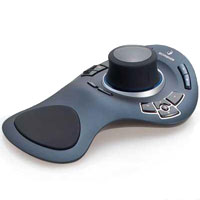
What does this device do? Does is actually reduce 50% of mouse clicks and make you more productive? I have a mouse to select stuff, a keyboard to type stuff and now a I have a 3D Mouse to rotate stuff. It looks cool, but I want it to do more than provide another way to spin a model around. Let’s see what this thing can do.
Brief Overview
Basically, the SpaceExplorer allows you to manipulate your model in space and set up some quickkeys. It’s similar to how the middle scroll wheel on the mouse works when pressed down, except you don’t have to drag the Explorer around and it’s a heck-uv-alot smoother, plus it’s got some extra goodies like the ability to move sub-parts. It doesn’t replace the keyboard or the mouse, but is there to supplement it. Sooo… I’m going to attempt to replace as much dependence on my keyboard as possible. I hate having to move around too much. It confuses me.
The Price?
The SpaceExplorer is 3DConnexion’s mid-range product. It runs $299 retail. The next level up is the SpacePilot that apparently has the same productivity gains, but cost $399 retail for a shiny LCD and 21+ programmable keys. You can pick up a SpaceNavigator (see below) for $59 that is only the 3D controller.
Un-Extreme Photo Montage

Here you see how I have cleaned up my desk to show the Explorer set up to the left of my keyboard. It’s smaller than you think when you it by itself. It’s very comfortable for the hand but not to sleep on.

I compared it with the SpaceNavigator. The Explorer weighs less, surprisingly. The 3D controls are the same, but it’s nice having those buttons on the Explorer for sure. I’ll go over that later.

Does this photo make it look fat? The buttons are located close to where your fingers are. You (like I) may find it awkward to find the button you want to push at first. If your hands are massive, you will want to throw this in a dark corner sometimes.

A side-by-side of the SpaceNavigator (left) and SpaceExplorer (right.) One is smaller than the other.
Working in SolidWorks
I like to just try things out first without reading through anything or getting any guidance. Helps to see how intuitive the design and program is.
My whole goal here is to get away from using the keyboard when in SolidWorks. Obviously, I’ll need to type some notes here and there, but when I’m designing I don’t want to move back and forth between devices. That’s just more annoying than someone chomping their teeth right in front of my face. slap.
I used this on SolidWorks 2007 and 2008. It was MUCH easier to set things up for 2008. Not because the programmable buttons work any different, but because of the SolidWorks Interface. *gasp!* Pure and Simple, the “annoying” SolidWorks context menu that pops-up when you select things allowed me to assign buttons to other commands. Assign one of the buttons to bring up the Shortcut bar and you’ll get even more command you can push to the SpaceExplorer.
It was pretty easy to adjust to, but I kept wanting to go back to the keyboard at times. If I started to, I would find how to incorporate the command into the SpaceExplorer. You can also set it up differently for parts, assemblies and drawings. Here’s the button mapping settings I use for assemblies.

The only thing I did differently for parts is change buttons 1 and 2 to macros I recorded in SolidWorks. For drawings I used typical commands like annotions, measure and then some custom marcros.
Macros in SolidWorks
To assign macros you’ve created in SolidWorks, you need to add them to a toolbar or keyboard shortcut that is not a letter or number. For example, if you have a Coincident Mate macro keyboard shortcut you need to assign it to a key like Insert, Home, Page Up, etc. in order to map it to the SpaceExplorer button.
Likes
- You can select a point or axis to rotate around
- You can move sub-parts, very nice
- If you have SolidWorks 2007 and 2008 installed you don’t have to set-up both
- For other programs, you can record a macro and set it to a button
- Rotation and Panning are just so much more smoother than a mouse
Dislikes
- The buttons are a bit loud; wish they were more like a soft-touch keyboard button.
- The Button Mapping for SolidWorks is different from the Control Panel button configuration on other programs.
- I still need to use my keyboard. Picky, I know, but the fewer input device the better in my opinion.
- No Tab Button. I use it so often, it would be better to have one than set a button to it. (I set it to ‘L’)
- No support for ‘Other’ commands in SolidWorks. Maybe this is SolidWorks Fault since those commands are not categorized. The Shortcut Bar for example.
Conflicts
I didn’t find any conflicts between programs. Occasionally, the fit command would not work, but it was only when the part had gone way off the screen. I reduced the sensitivity and everything worked fine.
Some Extra Tips
- When you start the SpaceExplorer in 2008 you may need to enable rotation by selecting Tilt/Spin/Roll from the menu. It wasn’t set by default for me.
- I would turn on Auto-Rotation in the Properties on the menu.
- Use the T, L, R, and F buttons for other than view commands.
Adding functionality for other applications
The first application I actually tried the SpaceExplorer with was Adobe Acrobat 8.0 3D. I gotta admit, it wasn’t the best to try out first, but it got me use to the Control Panel and App Configuration and helped when I got to the SolidWorks Button Mapping that is completely different. Here’s my recommendations for other programs.
- Set up Tab keys
There’s no Tab key on the SpaceExplorer, so if you use this a lot to switch application or windows definitely set up a custom function to handle this. - Increase Sensitivity I like to work fast and having the sensitivity set real low for the SpaceExplorer can be annoying at first. Put it all the way up. Try to get use to that and bring it down if it’s too hard to control.
- Use macros
This is one thing you can’t do with the SpaceExplorer in SolidWorks (you have to create a macro in SolidWorks, then assign it to the keyboard.)
For Adobe Acrobat 8 3D specifically
You will need to set up a custom fit macro for the 2D PDFs because the default fit doesn’t do it. The 3D environment is easy to move around in and you can assign all 15 keys to do something include record macros. Would be nice to have that in SolidWork.
Conclusion
At one point I had the thought, “What is this allowing me to do that I can’t do with my 2-button scroll-wheel mouse and the keyboard?” I think it’s impossible to get every single function onto the SpaceExplorer unless you don’t use a keyboard for any shortcuts. In that case you’ll have 11 buttons you can set up for each filetype in SolidWorks. If you use the keyboard a lot, this will be a supplement to how you work in SolidWorks but it does allow you to get the majority of your other shortcuts over to the left side of the keyboard to minimize the amount of moving back and forth.
I would definitely prefer this for presentation and general modeling efforts that would be used in a training class. I’m not so sure it decreased mouse clicks for me though, since I use a lot of keyboard shortcuts. I was clicking buttons on the SpaceExplorer, but those were all transfered from keyboard shortcuts.
What particularly cool is how much more moving around you do with your model. If you had the coordination down you could almost model and rotate at the same time. Seeing all the angles catches some problems and you get use to working in a different environment beside LEFT, TOP and RIGHT. I think that is called 3D. After using this I am convinced, if you can tear yourself away from major keyboard usage this can improve your workflow. Depending on how much you use it, I would give yourself a good 3-10 day learning curve to adjust to it.
My only wish for right now is that it could replace the mouse and keyboard entirely. I’m sure someone really ingenious could mod it to put an arm on it, add some haptic controls, a touchpad for mouse movements and a toggle for a slick pop-up keyboard on the screen.
What do you think? Have you used one and found it to help improve your productivity?



